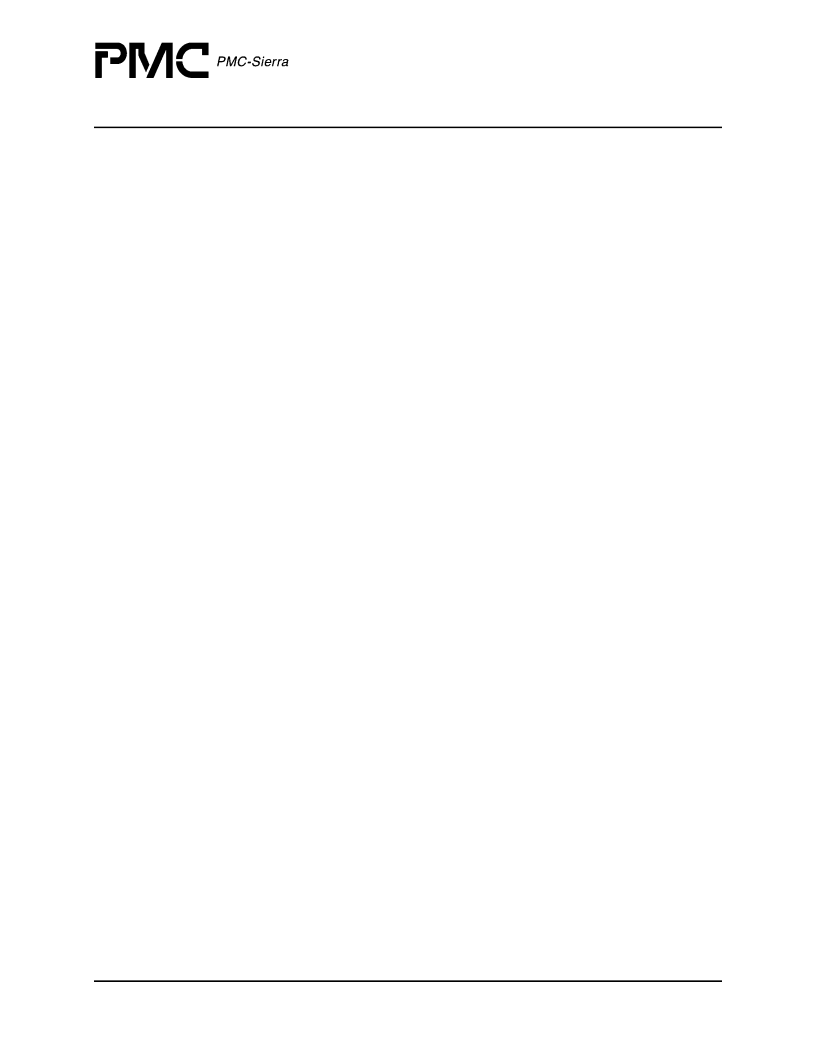- 您現(xiàn)在的位置:買(mǎi)賣(mài)IC網(wǎng) > PDF目錄368064 > PM5372-BI Telecommunication IC PDF資料下載
參數(shù)資料
| 型號(hào): | PM5372-BI |
| 英文描述: | Telecommunication IC |
| 中文描述: | 通信集成電路 |
| 文件頁(yè)數(shù): | 52/169頁(yè) |
| 文件大小: | 989K |
| 代理商: | PM5372-BI |
第1頁(yè)第2頁(yè)第3頁(yè)第4頁(yè)第5頁(yè)第6頁(yè)第7頁(yè)第8頁(yè)第9頁(yè)第10頁(yè)第11頁(yè)第12頁(yè)第13頁(yè)第14頁(yè)第15頁(yè)第16頁(yè)第17頁(yè)第18頁(yè)第19頁(yè)第20頁(yè)第21頁(yè)第22頁(yè)第23頁(yè)第24頁(yè)第25頁(yè)第26頁(yè)第27頁(yè)第28頁(yè)第29頁(yè)第30頁(yè)第31頁(yè)第32頁(yè)第33頁(yè)第34頁(yè)第35頁(yè)第36頁(yè)第37頁(yè)第38頁(yè)第39頁(yè)第40頁(yè)第41頁(yè)第42頁(yè)第43頁(yè)第44頁(yè)第45頁(yè)第46頁(yè)第47頁(yè)第48頁(yè)第49頁(yè)第50頁(yè)第51頁(yè)當(dāng)前第52頁(yè)第53頁(yè)第54頁(yè)第55頁(yè)第56頁(yè)第57頁(yè)第58頁(yè)第59頁(yè)第60頁(yè)第61頁(yè)第62頁(yè)第63頁(yè)第64頁(yè)第65頁(yè)第66頁(yè)第67頁(yè)第68頁(yè)第69頁(yè)第70頁(yè)第71頁(yè)第72頁(yè)第73頁(yè)第74頁(yè)第75頁(yè)第76頁(yè)第77頁(yè)第78頁(yè)第79頁(yè)第80頁(yè)第81頁(yè)第82頁(yè)第83頁(yè)第84頁(yè)第85頁(yè)第86頁(yè)第87頁(yè)第88頁(yè)第89頁(yè)第90頁(yè)第91頁(yè)第92頁(yè)第93頁(yè)第94頁(yè)第95頁(yè)第96頁(yè)第97頁(yè)第98頁(yè)第99頁(yè)第100頁(yè)第101頁(yè)第102頁(yè)第103頁(yè)第104頁(yè)第105頁(yè)第106頁(yè)第107頁(yè)第108頁(yè)第109頁(yè)第110頁(yè)第111頁(yè)第112頁(yè)第113頁(yè)第114頁(yè)第115頁(yè)第116頁(yè)第117頁(yè)第118頁(yè)第119頁(yè)第120頁(yè)第121頁(yè)第122頁(yè)第123頁(yè)第124頁(yè)第125頁(yè)第126頁(yè)第127頁(yè)第128頁(yè)第129頁(yè)第130頁(yè)第131頁(yè)第132頁(yè)第133頁(yè)第134頁(yè)第135頁(yè)第136頁(yè)第137頁(yè)第138頁(yè)第139頁(yè)第140頁(yè)第141頁(yè)第142頁(yè)第143頁(yè)第144頁(yè)第145頁(yè)第146頁(yè)第147頁(yè)第148頁(yè)第149頁(yè)第150頁(yè)第151頁(yè)第152頁(yè)第153頁(yè)第154頁(yè)第155頁(yè)第156頁(yè)第157頁(yè)第158頁(yè)第159頁(yè)第160頁(yè)第161頁(yè)第162頁(yè)第163頁(yè)第164頁(yè)第165頁(yè)第166頁(yè)第167頁(yè)第168頁(yè)第169頁(yè)

TSE Transmission Switch Element Datasheet
Released
Proprietary and Confidential to PMC-Sierra, Inc., and for its Customers’ Internal Use
Document ID: PMC-1991258, Issue 7
52
The SSWT is equivalent to a crossbar, with separate switch settings taken from control tables for
each egress channel for each 8B/10B time period (77.76 MHz). Multicast is supported by
permitting any number of output columns to take a sample from any input row at the same time.
The SSWT contains two sets or pages of control registers to control the switching function. Each
set of control registers consists of twelve registers (one per time step) of six bits (to select among
64 sources) for each of 64 egress ports. These registers are accessible from the microprocessor
interface; they constitute 2*12*6*64 = 9216 bits. Selection of the switching page is determined
by the device CMP pin, or through the microprocessor control interface.
Another control register in the SSWT allows specification of the delay between the system
synchronization pulse and J0 arrivals at the TSE receive analog blocks.
The SSWT is implemented by a set of input-selector muxes at each output.
9.5
Egress Time Switch Element (ETSE)
The ETSE accepts STS-12-aligned cyclic groups of twelve STS-1 samples over twelve time steps
from the Space Switch, and outputs these samples in an arbitrary Time permutation to the Egress
Ports. The time permutation is determined by the contents of two switching control register sets
or pages, each of which describes which STS-1 sample should be output during the ith (1 <= i
<=12) STS-1 time slot. These control registers are accessible via the microprocessor bus.
Selection of the switching page is determined by the device CMP pin, and on a per ETSE basis
through the microprocessor control interface.
The ETSE can also be set in a BYPASS mode in which no switching is done. When in BYPASS
mode, the latency of the ETSE is the same as when it is in DYNAMIC (switching) mode.
The egress time stage is implemented as two 12 STS-1 buffers, one to accumulate the incoming
stream and the other to accept twelve STS-1s in parallel and then deliver these samples in the
order specified by the switching control settings.
9.6
Transmit 8B/10B Disparity Encoder (T8DE)
The T8DE block corrects the running disparity of an 8B/10B character stream and buffers data in
a FIFO before transmission to the PISO block. A total of 64 T8DE blocks are instantiated in the
TSE device.
The input data to the T8DE blocks originated from the R8FA blocks at which point they have
correct running disparity. However, due to the time and space re-arrangement activities of the
TSE, the running disparity is no longer consistent. The T8DE block inverts the 6B and 4B sub-
characters to ensure correct running disparity.
相關(guān)PDF資料 |
PDF描述 |
|---|---|
| PM5380 | PMC-2010299 S/UNI-8x155 Telecom Standard Product Data Sheet [1.91 MB] |
| PM554 | Programmable Quad Supply Monitor with Adjustable Reset and Watchdog Timers; Package: SSOP; No of Pins: 16; Temperature Range: -40°C to +85°C |
| PM555 | 1 to 10 watt encapsulated power modules |
| PM556 | Precision Quad Supply Monitor in 6-Lead SOT-23; Package: SOT; No of Pins: 6; Temperature Range: 0°C to +70°C |
| PM560 | Precision Quad Supply Monitor in 6-Lead SOT-23; Package: SOT; No of Pins: 6; Temperature Range: 0°C to +70°C |
相關(guān)代理商/技術(shù)參數(shù) |
參數(shù)描述 |
|---|---|
| PM5372BIP | 制造商:PMC-Sierra 功能描述: |
| PM5372-BI-P | 制造商:PMC-Sierra 功能描述: |
| PM5376HFI | 制造商:PMC-Sierra 功能描述: |
| PM5377 | 制造商:PMC 制造商全稱(chēng):PMC 功能描述:Single Chip 96-Port STS-1/STM-0 Cross-Connect |
| PM537CE | 制造商:ARTESYN 制造商全稱(chēng):Artesyn Technologies 功能描述:Single, dual and triple output 1 to 10.5 Watt AC/DC encapsulated modules |
發(fā)布緊急采購(gòu),3分鐘左右您將得到回復(fù)。